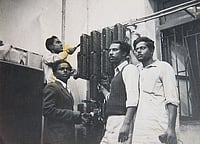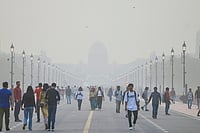With four periods of military rule and constant interference by the military even in eras of civilian rule,Pakistan's democratic system has still not been able to establish firm roots. Thoughmodelled on the British parliamentary system, Pakistan's military rulers, from Ayub to Musharraf,have tried to impose a semi-presidential system without much success.
One of Pakistan's leading political scientists, Khalid Bin Sayeed, has often called the Pakistani political system as aviceregal system: a continuation of the British system with the indirectly elected President acting like the omnipotent viceroy, rather than relinquishing powers to a directly elected Prime Minister. Right from the days of Ghulam Muhammad and Iskander Mirza, through Ayub and Zia till Musharraf, the Presidents have sought to hold more power. Ayub even temporarily changed Pakistan to a Presidential system as he believed that was'more suitable' to Pakistan.?
In 2003 former President Musharraf brought forth the 17th Amendment to the Constitution by which under Article 58 2(b) the President has the right to dissolve the National Assembly and dismiss the Prime Minister. The PPP,Mr? Zardari's party, insisted even before the 2008 elections that this amendment would be repealed. The fact that President Zardari has not yet repealed the 17th Amendment to the Constitution is a reflection of the fact that he does not want to do anything which might lessen his power vis-à-vis the Prime Minister.
Balance Of Power
Right from the days of Ghulam Muhammad and Iskander Mirza, through Ayub and Zia till Musharraf, the presidents have sought to hold more power in Pakistan than the directly elected prime ministers. It is Mr Zardari's turn now...

Musharraf was not the first Pakistani President to insert a provision which would give him the power to dismiss a directly elected Prime Minister. Iskander Mirza abrogatedPakistan's first Constitution in 1956 and dismissed the Parliament primarily because the Assembly had incorporated an amendment which would prevent the Governor General from dismissing the Prime Minister or elected government. Martial law and a semi-presidential system gave Ayub complete authority which was then passed on toYahya.
In 1985, under Zia, the Eighth Amendment to the Pakistani Constitution was passed which introduced Article 58 2(b). This article gave the President of Pakistan the right to dissolve the National Assembly and dismiss the Prime Minister. WhenZia's handpicked Prime Minister Junejo started making independent decisions, Zia used this amendment to dismiss Junejo in 1988.
During the 1990s, Presidents Ghulam Ishaq Khan and Leghari used the power they had inherited under the Eighth Amendment and Article 58 2(b) to dismiss the elected Prime Ministers. In 1997, Nawaz Sharif used his overwhelming majority in both the National Assembly and Senate to repeal the Eighth Amendment by passing the Thirteenth Amendment. This Amendment stripped the President of the power of dismissing the Prime Minister or dissolving the National Assembly.Musharraf's 17th Amendment basically reintroduced Zia's system.
The present civilian government inherited this legacy and even though both the President and Prime Minister belong to the same party there have been tensions from the very beginning. Prime Minister Gilani believes that as the directly elected prime minister he must have the final say on all important matters. However, whether it is the international arena and the high-level dealings with the Americans or the domestic arena and the Chief Justice crisis, President Zardari seems to be the'decider.' Part of the problem has to do with the personality of the incumbents: President Zardari believes he is shouldering hiswife's legacy and instead of following a hands-free policy has adopted a very hands-on approach.
Another part of the problem has to do with the role of political intrigues within any administration. Bureaucracies, both civilian and intelligence, benefit from playing the various powercentres against each other, in order to justify the importance of the bureaucracy. Politicians and rulers who have vast administrative experience know how to deal with these intrigues, newcomers often fall prey to them. Very few ofPakistan's present day political leaders have long administrative experience and so often fall prey to these internal intrigues.
The March 2009 crisis demonstrated the tensions between the Prime Minister and the President. It was apparent that Prime Minister Gilani was not very happy with PresidentZardari's decisions. The close ties between Prime Minister Gilani and the Sharif brothers were also visible as Nawaz Sharif publicly asked the Prime Minister to do something to solve the problem. As Nawaz Sharif stated on March 17"The PM has been neutral on this issue. Of course, it is Mr Zardari who actually did not honor his commitment, but PM personally made no commitment to us and all along he's been quitesupportive."
Prime Minister Gilani, however, has time and again reiterated that he will "change the system", which gives sweeping powers to the President. The Prime Minister has often vowed to return toPakistan's National Assembly the authority it lost in 2003. As Mr? Gilani has often stated, "We have to return to parliamentary democracy on the lines of Westminster." This means not only a repealing of the 17th Amendment and thus a de jure reduction in power of the President, but also a de facto change.
Prime Minister Gilani would like a change in the current 'balance of power' between the twocentres. The differing views of the Prime Minister and President on 'balance ofpower' was recently seen when the PPP information secretary Fauzia Wahab said that the prime minister should not be"so strong" and there should be a "balance of power" between him and the president. Prime Minister Gilani retorted by saying,"What Fauzia Wahab says does not matter; it is for the nation to decide."
Time and again, conflicts between Pakistan's political leaders and their desire for absolute power and control have opened the door for military coups and autocratic rule. There is nothing new or strange about disagreements between variouscentres of power in any political system. The problem in Pakistan, however, is that since the political system has never formed firm roots most political conflicts-- whether minor or major -- have rarely remained limited to the political arena.
In most democracies conflicts between the executive and judiciary or between the executive and legislature are routinely decided within the chambers of these institutions. In Pakistan, the aggrieved political partytends to try to demonstrate its street power. However, the end result has rarely been what the political party or power group hoped to achieve and has normally resulted in a military coup.
We saw this as early as 1952-1953 when two Muslim Leaguers, Daulatana and Mamdot, fought for the post of chief minister of Punjab and each side demonstrated his power through street protests. The anti-Ayub demonstrations in the late 1960s, the anti-Ahmadiyya demonstrations in 1973 and the anti-Bhutto movement in the late 1970s followed a similar pattern. Both Nawaz Sharif and Benazir Bhutto used street protests tode-legitimise the other's rule during the 1990s.
In each case, the political parties are not able to control these demonstrations and often give in to the street power of the Islamist parties. Often the military sees this as an opportunity to walk in and take over power. The military is able to show that the'parliamentary system' is ineffective and unsuitable to Pakistan and the political parties and their leaders are inefficient, quarrelsome, power-hungry and corrupt.
Pakistan has faced political uncertainty for most of its 62 years of existence. What Pakistan, and Pakistanis, need today is political stability. BothMr? Gilani and Mr? Zardari spent years in prison as political prisoners. One hopesthey will not repeat the mistakes of the past and this time round Pakistan will experience years of democratic rule.
Aparna Pande is a doctoral candidate and lecturer in political science at Boston University.




















